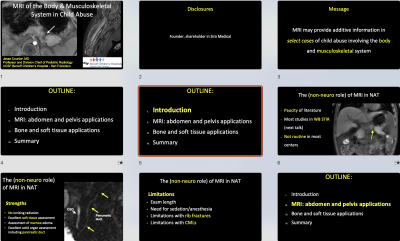Weekend Course
Unveiling the Invisible: MRI’s Potential Role in Assessing Child Abuse
ISMRM & ISMRT Annual Meeting & Exhibition • 04-09 May 2024 • Singapore

| 13:15 |
Mechanisms, Medicolegal Issues & Reporting of Child Abuse
Harvey Teo
|
|
| 13:40 |
MRI of the Brain, Spinal Cord & Spine in Child Abuse
Rupa Radhakrishnan
|
|
| 14:05 |
 |
MRI of the Body & Musculoskeletal System in Child Abuse
Jesse Courtier
Keywords: Body: Urogenital, Cross-organ: Pediatric, Musculoskeletal: Skeletal Abuse-related trauma in children involving the abdomino-pelvic and musculoskeletal systems is unfortunately common, and MRI is uncommonly utilized as a primary modality in this setting. There are, however, specialized indications in which MRI can provide additional clinically-relevant information can that impact management. These indications include assessment of pancreatic / pancreatic duct injury, sequela of pelvic inflammatory disease, and genital trauma. Musculoskeletal and soft tissue injuries and their extent can also be well documented using MRI. MRI can provide a complementary role in these types of indications. |
| 14:30 |
Role of Whole-Body & Post-Mortem MRI in Child Abuse
Teresa Victoria
|
|
| 14:55 | Break & Meet the Teachers |
The International Society for Magnetic Resonance in Medicine is accredited by the Accreditation Council for Continuing Medical Education to provide continuing medical education for physicians.